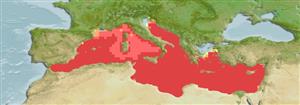Common names from other countries
Environment: milieu / climate zone / depth range / distribution range
Ökologie
seewasser; ozeanodrom (Ref. 51243); tiefenbereich 0 - 200 m (Ref. 43). Deep-water; 46°N - 30°N, 6°W - 36°E (Ref. 43)
Mediterranean Sea: considerably abundant around Italy. No confirmed report from the Black Sea. No adults have been reported east of the Ionian Sea. Highly migratory species. Reportedly caught from the Aegean Sea (Pennetti, pers. comm.).
Size / Gewicht / Alter
Maturity: Lm ? range ? - ? cm
Max length : 240 cm TL Männchen/unbestimmt; (Ref. 4770); common length : 200 cm OT Männchen/unbestimmt; (Ref. 43); max. veröff. Gewicht: 70.0 kg (Ref. 43)
This species is the most common istiophorid in the central basin of the Mediterranean and completes its life cycle inside this sea as far as is known to date. Probably swims in the upper 200 m water layer, generally above or within the thermocline. Travels in pairs, possibly corresponding to a feeding behavior. Feeds on fishes. Probably more widespread in the Mediterranean Sea and may have been identified as T. albidus by anglers and fishermen.
Life cycle and mating behavior
Geschlechtsreife | Fortpflanzung | Ablaichen | Eier | Fecundity | Larven
Winter and spring might not be an unreasonable hypothesis for the spawning season of this species.
Nakamura, I., 1985. FAO species catalogue. Vol. 5. Billfishes of the world. An annotated and illustrated catalogue of marlins, sailfishes, spearfishes and swordfishes known to date. FAO Fish. Synop. 125(5):65p. Rome: FAO. (Ref. 43)
IUCN Rote Liste Status (Ref. 130435)
CITES (Ref. 128078)
Not Evaluated
Bedrohung für Menschen
Harmless
Nutzung durch Menschen
Fischereien: weniger kommerziell
Mehr Information
ReferenzenAquakulturAquakultur ProfilZuchtlinienGenetikElectrophoresesVererbbarkeitKrankheitenVerarbeitungMass conversion
PartnerBilderStamps, Coins Misc.LauteCiguateraGeschwindigkeitSchwimmstilKiemenoberflächeOtolithsGehirngrößeSehfähigkeit
Tools
Zusatzinformationen
Download XML
Internet Quellen
Estimates based on models
Preferred temperature (Ref.
115969): 13.7 - 19.3, mean 15.3 (based on 121 cells).
Phylogenetic diversity index (Ref.
82804): PD
50 = 0.5630 [Uniqueness, from 0.5 = low to 2.0 = high].
Bayesian length-weight: a=0.00447 (0.00193 - 0.01034), b=3.14 (2.94 - 3.34), in cm Total Length, based on LWR estimates for this (Sub)family-body shape (Ref.
93245).
Trophic level (Ref.
69278): 4.4 ±0.63 se; based on food items.
Widerstandsfähigkeit (Ref.
120179): niedrig, Verdopplung der Population dauert 4,5 - 14 Jahre. (Assuming tmax>10).
Fishing Vulnerability (Ref.
59153): Very high vulnerability (90 of 100).
